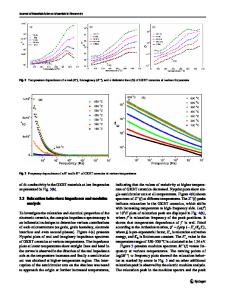Dielectric relaxation and electrical properties of Na 0.5 Bi 4 La 0.5 Ti 4 O 15 electroceramics
- PDF / 1,716,954 Bytes
- 7 Pages / 595.276 x 790.866 pts Page_size
- 10 Downloads / 332 Views
Dielectric relaxation and electrical properties of Na0.5Bi4La0.5Ti4O15 electroceramics Fida Rehman 1,2 & Jing-Bo Li 1 & Pervaiz Ahmad 3 & Yasir Saeed 2 & Hai-Bo Jin 1 Received: 26 October 2018 / Accepted: 8 March 2020 # Springer Science+Business Media, LLC, part of Springer Nature 2020
Abstract Aurivillius single-phase Na0.5Bi4La0.5Ti4O15 ceramics was prepared via solid state mixed oxide sintering technique. The ac data in terms of dielectric and impedance were collected to investigate the electrical properties and dielectric relaxation behaviors in the ceramics. The detailed frequency spectrum analysis demonstrates the existence of single dielectric relaxation behavior in the material, which is due to the grains contribution. A phase transition was observed to take place at ~570 °C. Ar-annealing study showed that above ∼280 °C, relaxation and conduction of the ceramics was assigned to the motion of ionized oxygen vacancies. The kinetic analysis was performed to probe the conduction-relaxation mechanisms in the ceramics. The present results could be significant for deep understanding of electrical properties and defect-relaxation behaviors in Na0.5Bi4La0.5Ti4O15 related ceramics. Keywords Dielectric . Impedance analysis . Electrical properties . Defects . Aurivillius compound
1 Introduction Aurivillius layered structured compounds have recently attracted renewed attention due to its significant scientific importance in many technological and industrial applications such as transducers, ionic conductors, high temperature piezoelectric devices, memory devices, and (Pb-free)
* Fida Rehman [email protected] Jing-Bo Li [email protected] Pervaiz Ahmad [email protected] Yasir Saeed [email protected] Hai-Bo Jin [email protected] 1
Beijing Key Laboratory of Construction Tailorable Advanced Functional Materials and Green Applications, School of Materials Science and Engineering, Beijing Institute of Technology, Beijing 100081, China
2
Department of Physics, Abbottabad University of Science and Technology, Havelian, KP, Pakistan
3
Department of Physics, University of Azad Jammu & Kashmir, Muzaffarabad 13100, Pakistan
environmentally friendly behavior [1–8]. Aurivillius phases have been extensively investigated owing to its structural flexibility and unique crystalline structure. They are generally formulated as (Bi2O2)2+(Am-1BmO3m + 1)2− and their structure is presented by the regular intergrowth of layers (Bi2O2)2+ and (Am-1BmO3m + 1)2− blocks, where m indicates the pseudoperovskite units [9, 10]. Aurivillius Layer-structured materials are known to have high Curie temperature and large spontaneous polarization [5, 11, 12]. Besides its noteworthy properties their high conductivity is still very challenging factor for the scientists and researchers. Numerous efforts have been undertaken in improving their properties. Recently it is demonstrated that bismuth layer-structured materials are highly affected due to various defect behaviors, especially oxygen vacancies [13–16]. It was demonstrated that rare-earth io
Data Loading...










